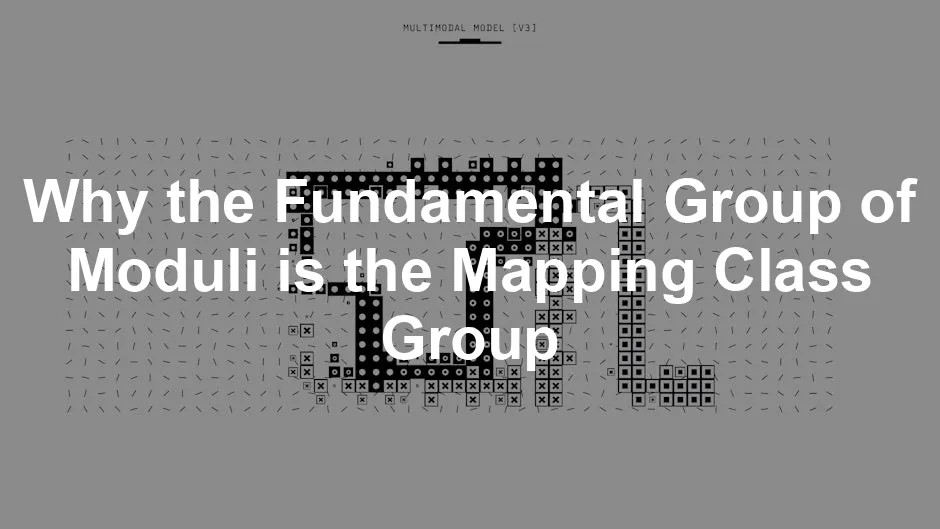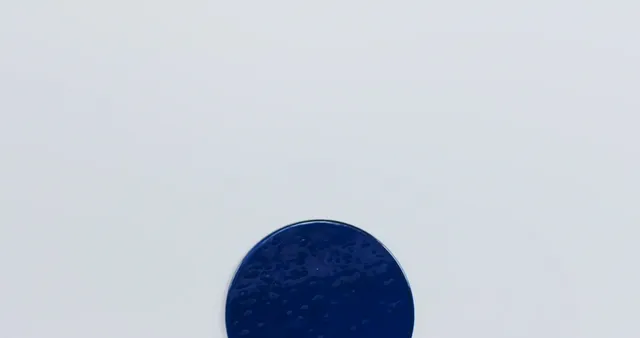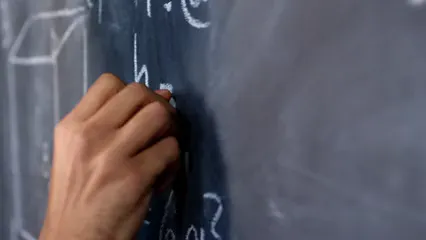
Why the Fundamental Group of Moduli is the Mapping Class Group
Introduction
Understanding the link between the fundamental group of moduli spaces and the mapping class group is crucial. This connection spans several mathematical fields, including topology and algebraic geometry. It also plays a significant role in the study of Riemann surfaces, offering insights into their structure and classification.
If you’re just starting out with topology, it might be beneficial to check out Topology for Beginners. This book simplifies complex concepts and helps build a solid foundation, making it easier to tackle more advanced topics down the road.
Summary and Overview
In this section, we will explore the significance of the mapping class group as the fundamental group of moduli spaces. The mapping class group captures the symmetries of surfaces, acting on Teichmüller spaces. It serves as a bridge connecting topology with algebraic geometry, particularly in the classification of Riemann surfaces.
We will introduce key concepts such as Teichmüller spaces, which are contractible spaces that help us understand the deformation of surfaces. Additionally, we will touch upon homotopy classes, which represent different ways surfaces can be continuously transformed. Understanding these relationships helps us grasp the rich structure of surfaces and their automorphisms, revealing how abstract concepts in mathematics interconnect.
For those interested in a deeper dive into Riemann surfaces, you might want to explore Riemann Surfaces Explained. This book breaks down complex ideas into digestible pieces, making the intricate world of Riemann surfaces more approachable.
Theoretical Foundations
Definition of the Mapping Class Group
The mapping class group is a key concept in topology. It consists of homeomorphisms of a surface, considered up to isotopy. Essentially, two homeomorphisms are deemed equivalent if one can be continuously deformed into the other without tearing or gluing. This group captures the symmetries of the surface.
To construct the mapping class group, we take the group of orientation-preserving homeomorphisms and factor out those isotopic to the identity. This leads to the notation Mod(S) = \frac{Homeo^+(S)}{Homeo_0(S)}. The mapping class group also connects deeply with automorphism groups, as each homeomorphism induces an automorphism of the fundamental group. This relationship is vital in understanding how surfaces behave under various transformations.
For a comprehensive understanding of algebraic geometry, check out Algebraic Geometry Essentials. This book provides essential concepts and insights that are invaluable in the study of the mapping class group and its applications.
Fundamental Group and Moduli Spaces
In topology, the fundamental group represents the set of loops on a space, capturing information about its shape. When we consider moduli spaces, particularly those of Riemann surfaces, the fundamental group becomes crucial. Moduli spaces parameterize families of geometric objects, revealing how these objects can deform.
For Riemann surfaces, moduli spaces classify surfaces up to isomorphism, taking into account complex structures. The fundamental group of these spaces arises naturally as we consider paths in the moduli space. Each loop corresponds to a different way to traverse the moduli space, highlighting the intricate relationships between various surfaces. This connection allows us to analyze how surfaces can be transformed into one another, revealing the underlying topology that governs their structure.
If you’re seeking a foundational text that covers various mathematical concepts, consider Mathematics: A Very Short Introduction. It’s a concise overview that can help you appreciate the interconnectedness of various mathematical fields.

Relationship Between Mapping Class Group and Fundamental Group
Mapping Class Group as Fundamental Group
The mapping class group is the fundamental group of the moduli space of Riemann surfaces. This relationship reveals how surfaces transform under homeomorphisms. Essentially, the mapping class group captures the symmetries of these surfaces.
Teichmüller spaces are crucial in this context. They provide a contractible space where each point represents a unique complex structure on a surface. When we take the quotient of the Teichmüller space by the mapping class group, we obtain the moduli space of Riemann surfaces. This quotient highlights how different surfaces can be continuously deformed into one another.
A key theorem related to this concept is the Dehn-Nielsen-Baer theorem. It states that any orientation-preserving homeomorphism of a closed surface induces an automorphism of its fundamental group. This connection is essential in understanding how homeomorphisms affect the algebraic structure of surfaces.
The mapping class group, therefore, serves as a bridge between the geometric properties of surfaces and their algebraic invariants. As we study these groups, we gain insights not only into the classification of Riemann surfaces but also into broader areas of algebraic geometry and topology. This interplay enriches our understanding of how abstract concepts in mathematics relate to one another.
For a deeper insight into Teichmüller theory, I recommend Introduction to Teichmüller Theory. This book provides a comprehensive foundation for understanding the significance of Teichmüller spaces in the context of mapping class groups.

Geometric Interpretation
The mapping class group has profound geometric implications. It encodes how surfaces can be manipulated through homeomorphisms. Each homeomorphism represents a way to stretch, twist, or otherwise transform a surface while preserving its topological properties.
In 3-manifold theory, the mapping class group’s significance becomes even clearer. For instance, the way surfaces are embedded within 3-manifolds influences the manifold’s overall structure. This relationship allows mathematicians to classify 3-manifolds based on their surface components.
Moreover, homeomorphisms help us visualize abstract topological ideas. They provide tangible examples of how surfaces interact in higher dimensions. By understanding the mapping class group, we can better appreciate the geometric richness of surfaces and their applications in various mathematical fields.
Examples and Applications
Examples of Mapping Class Groups
Mapping class groups provide fascinating insights into the symmetries of surfaces. Let’s look at some specific examples.
For a sphere, the mapping class group is simple. Any homeomorphism is isotopic to the identity. This means the mapping class group is trivial, denoted as MCG(S^2) \simeq \mathbb{Z}/2\mathbb{Z}. This reflects the fact that the only symmetries arise from rotations.
Now, consider the torus. The mapping class group here is much richer. It is isomorphic to the modular group SL_2(\mathbb{Z}). This group captures the complex interactions within the torus, including the fascinating properties of its symmetries.
For surfaces of higher genus, the mapping class groups become increasingly complex. A closed surface of genus g has a mapping class group that combines various Dehn twists. Each Dehn twist corresponds to a specific loop on the surface. These twists are essential as they generate the mapping class group, allowing rich interactions among surfaces.

In summary, mapping class groups differ dramatically depending on the surface. From trivial cases like the sphere to intricate structures in higher genus surfaces, these groups provide a powerful tool to study geometric properties and transformations in topology.
If you’re interested in a broader perspective on topology, consider reading Topology and Its Applications. This book delves into practical applications of topology in various fields, making it a great addition to your mathematical library.
Applications in Algebraic Geometry
Mapping class groups play a significant role in algebraic geometry, especially in classifying curves and surfaces. They help understand moduli spaces, which parameterize families of geometric objects.
In particular, mapping class groups assist in studying the moduli space of Riemann surfaces. This space captures the different complex structures of surfaces. By analyzing these groups, mathematicians can identify how surfaces deform and relate to each other.
Furthermore, mapping class groups are instrumental in understanding algebraic curves. They provide a framework for analyzing the automorphisms of curves, revealing symmetries that inform classification. This connection between topology and algebraic geometry enriches our understanding of both fields, bridging gaps and fostering deeper insights into the nature of surfaces and their transformations.

If you’re looking for a practical guide to algebraic geometry, check out Introduction to Algebraic Geometry. This book serves as a valuable resource for those venturing into the world of algebraic structures and their applications.
Advanced Connections
Interaction with Other Mathematical Concepts
The mapping class group (MCG) interacts significantly with braid groups and outer automorphism groups. For instance, the MCG of a punctured disk is isomorphic to the pure braid group on the same number of strands. This connection highlights how surface manipulations can be viewed through the lens of braid theory. Additionally, outer automorphism groups of free groups reveal further interactions with the MCG, especially in the study of automorphisms induced by homeomorphisms of surfaces.
In geometric group theory, the MCG serves as a critical example. It showcases properties such as hyperbolicity and serves as a rich source of examples for studying word metrics. The interplay between these groups allows researchers to explore the algebraic structures inherent in topology. Overall, understanding these interactions deepens our grasp of the underlying principles in both geometric and algebraic topology.

Recent Developments and Research
Recent breakthroughs in mapping class group research have uncovered new applications in various mathematical fields. For example, advancements in understanding the MCG’s action on Teichmüller spaces have led to insights into the dynamics of surface homeomorphisms. This research has also prompted discussions on the stability of the MCG under various topological constraints.
Ongoing research focuses on open questions like the relationship between the MCG and the cohomology of moduli spaces. Another intriguing area is the potential for applications in quantum topology, particularly concerning topological quantum field theories. As new connections emerge, mathematicians continue to explore how the MCG can illuminate broader concepts in mathematical theory, solidifying its importance in contemporary mathematics.

Conclusion
In summary, the mapping class group is vital to understanding the fundamental group of moduli spaces. It encapsulates the symmetries of Riemann surfaces and fosters connections between topology and algebraic geometry. By grasping the intricacies of the MCG, we gain valuable insights into the classification of surfaces and their transformations. I encourage you to explore this fascinating topic further, as it holds profound implications across various areas of mathematics.
If you’re interested in a comprehensive overview of mathematical ideas, consider The Princeton Companion to Mathematics. This book offers a wealth of knowledge that can enrich your understanding of the mathematical landscape.
The mapping class group is closely related to the fundamental group of moduli spaces, which is essential in understanding their structure. why fundamental group of moduli is mapping class group
Please let us know what you think about our content by leaving a comment down below!
Thank you for reading till here 🙂
All images from Pexels




